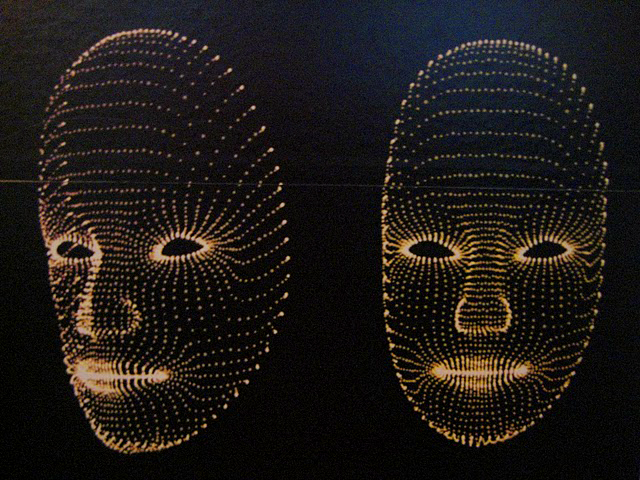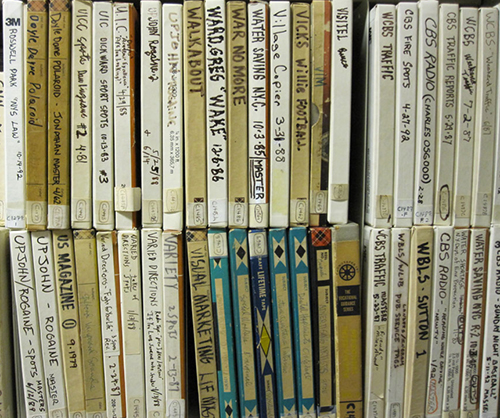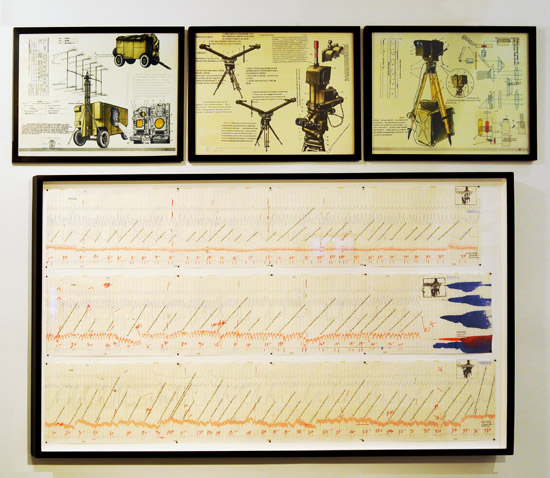Carol Irving likes to interrogate “the truth” in a gutted manner. She has been examining that “truth” not only in herself but also in over 600 volunteers through multiple “truth” happenings held at office spaces in Manhattan. I had the opportunity to meet with Carol at Carriage Trade, in which her piece PL/90-0559A is part of the group exhibition entitled Mistaken Identities. Using an original polygraph, which is an old-fashioned lie detector, on herself and on others for a period of over 18 years, Carol is onto something here. The results of these tests look strangely familiar, with marks and symbols that we seem to relate to, although not quite sure why or how. Then the questions begin to surface, such as Have you noticed your smells have changed as you’ve grown old? Do you know anyone named Art? Her images may seem surreal and fictitious but these polygraphic tests were once forced on individuals up until the late 80s. Being interrogated can be an unbearable experience, but transforming this into an art form becomes an attractive practice. I’d certainly be interested to surrender myself to become lines and numbers rendered by a guilt detecting device.
Multimedia
Artist In Focus: Joshue Ott
by Helen Homan Wu on July 27th, 2010
This week’s featured artist is an extended interview focusing on the work of multi-media visual artist Joshue Ott.
Joshue Ott is one of those innovative artists who visualizes new media in a broader spectrum. Having created superDraw, a platform in which he customized to become his visual instrument, along with multiDraw and Thicket, both interactive projects, Josh is constantly at the forefront. Working with soundscapes, his distinct style of visuals experiments with the basic qualities of form, texture and movement. Since 2005 Josh has been creating live visuals for numerous musicians and various performances around the world. I first experienced Josh’s work live at the 2010 Unsound Festival in New York. We had this conversation in his studio in Brooklyn where he lives with his wife and two children.
Helen Homan Wu: Okay, let’s talk about how you started superDraw. How long ago was it?
Joshue Ott: It was…years ago. Morgan Packard and Ezekiel Honig released Early Morning Migration and I played at the release party. It was some sort of debut. The first time I did superDraw live in front of people and called it superDraw.
Marshall McLuhan: the Effect of the Media
by Helen Homan Wu on July 22nd, 2010
Yesterday was Mr. Marshall McLuhan’s birthday. Anyone who read the cult classic The Medium is the Massage: An Inventory of Effects knows that Marshall McLuhan is the godfather of philosophical media analysis. He did deep studies about how the media could effect an individual, and although those theories were written in the 60s it can easily by applied to what’s happening now. This video interview is a good introduction to Mr. McLuhan’s work and would perhaps inspire us to question our own role in today’s machine-obsessed world.
SENSEable Cities: Exploring Urban Futures
by Megan Seelie on June 17th, 2010

Flyfire Team: Carlo Ratti, Assaf Biderman, Carnaven Chiu, E Roon Kang,
Caitlin Zacharias, Shaocong Zhou
An idea based gallery show with no tangible objects, everything in the exhibition SENSEable Cities: Exploring Urban Futures can be found online. The group show which is on now at GAFFTA Gallery consists of fifteen awesome and innovative projects chosen from MIT’s SENSEable Cities Laboratory that aim at posing questions and creating sustainable solutions to our rapidly evolving cities. The Copenhagen Wheel is just one solution that encourages sustainability and mobility by being a bicycle wheel that can turn your pushbike into an electric bike and communicate with your smart phone about traffic patterns and pollution levels along your route. However, the wheel was not at the gallery, in fact none of the projects had a tangible component, they were represented by wall texts, photos and a looping video. Everyone should be familiarized with MIT’s SENSEable Cities Laboratory, however, trekking all the way to GAFFTA Gallery to do so seems rather unnecessary when you can just flip your laptop open to http://senseable.mit.edu and see the whole show and much more.
A New Digital Landscape @US Library of Congress
by Helen Homan Wu on June 10th, 2010

(all images courtesy Rob Beschizza)
While the NY Public Libraries are under the stress of budget cuts, the nation’s Library of Congress has been busy digitizing its collections with a grand vision for the future. The Library of Congress houses the largest database in the world with original manuscripts, ancient books, renaissance-era maps, audio/video files, and historical artifacts. I came across an interesting photo essay by Rob Beschizza revealing some interesting facts about what is going on behind the library’s preservation department. It is both interesting and exciting to see how they are handling cultural artifacts using intelligence from specialists (perhaps researching from other countries as well) to realize a whole new digital culture, hence a different way of researching and learning.
My hope is that as they develop, they will preserve the traditional values of a library, as a powerful resource and cultural establishment, going into the future to advance digitally. As Eric Hansen, chief of the Preservation Research and Testing Division puts it, “You can learn about a culture from how it builds and stores things.” Browse the LoC’s digital collection online.
unitxt by Alva Noto featuring poet Anne-James Chaton
by Helen Homan Wu on May 19th, 2010
When I was told that Alva Noto would be performing at the Kitchen last night, I braved it to Chelsea just in time before he started his set. Carsten Nicolai a.k.a. Alva Noto is a minimalist sound artist, post-techno electronic musician. I started following his work since his early collaborations with Sakamoto Ryuichi. What I didn’t realize is that Mr. Nicolai also produces visuals. Last night’s performance was mind-blowing, literally, the heavily broken beats, blips, and prolonged static are sounds from faxes, modems and the telephone. They were in sync with the intense visuals which was manipulated real-time by Mr. Nicolai himself. There is something quite ecstatically surreal in this work in which he uses old technologies (with recordings by poet Anne-James Chaton) that throws you off the chair. It is the art of minimal simulation to the max. The show is presented by the Pace Gallery. More photos to come.
Unsound Festival – a medley
by Helen Homan Wu on February 8th, 2010
“Since 2003, Unsound Festival, Poland’s most adventurous music festival, has brought a bold and uniquely modern program of music to Kraków. Now, with seven festivals in their native city under their belt (and outpost events further east in cities like Minsk), Unsound is coming west to New York for their first ever North American edition. Unsound Festival New York’s mission is to forge new links between music genres, between generations and even between artistic practices. The driving force in the assembling of the New York program has been Unsound Festival’s commitment to forms of music and sound art that involve experimentation and risk. Unsound Festival has made a worldwide reputation by breaking new ground while dealing with vibrant electronic, experimental, independent, post-classical and club music scenes from around the world.”
Thursday February 4th opens an exciting series of sound, visual art and music events that has never happened in the East Coast of the States. If you follow any sort of experimental electronic music or video art, chances are you heard the waves coming. As an electronic beats enthusiast, I was extremely excited that the Unsound Festival is actually taking place in New York City. I’ve always been disappointed that the experimental electronic scene isn’t happening much here in my hometown compared to Berlin or London, but when I saw the lineup to Unsound I was more than impressed. The program boasts a nice mix of multidisciplinary art forms including electronic/post-rock/classical/neo-jazz music, sound art, experimental visuals… That is the best I can do to categorize — a lot of the work doesn’t cleanly fit into any one categorical box.
The first show begins appropriately at Lincoln Center’s David Rubenstein Atrium with an improvisational performance by Berlin video artist Lillevan (who’s also working on the Warhol Screen Tests) and Finland’s Vladislav Delay, followed by the avante-garde group Solid State Transmitters. This show was also part of the Thursday free Target shows, so the queue of people went around the block. Half of the people didn’t even get to step inside. I decidedly gave up, saving my energy for Saturday’s 8-hour long set of experimental improvised soundscapes from Group Show (Jan Jelinek, Hanno Leichtmann and Andrew Pekler).
The line-up looks like this:









 RSS
RSS
